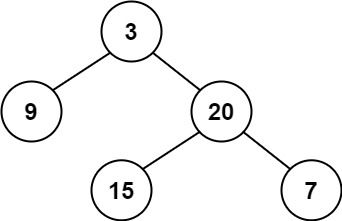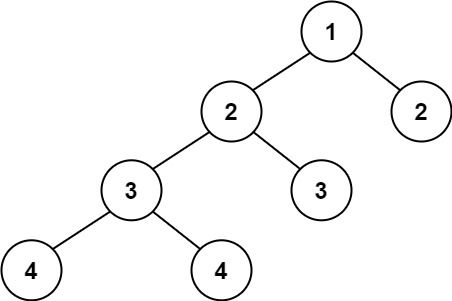给定一个二叉树,判断它是否是高度平衡的二叉树。
本题中,一棵高度平衡二叉树定义为:
一个二叉树每个节点 的左右两个子树的高度差的绝对值不超过 1 。
示例 1:
输入:root = [3,9,20,null,null,15,7] 输出:true
示例 2:
输入:root = [1,2,2,3,3,null,null,4,4] 输出:false
示例 3:
输入:root = [] 输出:true
提示:
- 树中的节点数在范围
[0, 5000]内 -104 <= Node.val <= 104
# Definition for a binary tree node.
# class TreeNode:
# def __init__(self, val=0, left=None, right=None):
# self.val = val
# self.left = left
# self.right = right
class Solution:
def isBalanced(self, root: TreeNode) -> bool:
def height(root):
if root is None:
return 0
l, r = height(root.left), height(root.right)
if l == -1 or r == -1 or abs(l - r) > 1:
return -1
return 1 + max(l, r)
return height(root) >= 0/**
* Definition for a binary tree node.
* public class TreeNode {
* int val;
* TreeNode left;
* TreeNode right;
* TreeNode() {}
* TreeNode(int val) { this.val = val; }
* TreeNode(int val, TreeNode left, TreeNode right) {
* this.val = val;
* this.left = left;
* this.right = right;
* }
* }
*/
class Solution {
public boolean isBalanced(TreeNode root) {
return height(root) >= 0;
}
private int height(TreeNode root) {
if (root == null) {
return 0;
}
int l = height(root.left);
int r = height(root.right);
if (l == -1 || r == -1 || Math.abs(l - r) > 1) {
return -1;
}
return 1 + Math.max(l, r);
}
}/**
* Definition for a binary tree node.
* function TreeNode(val, left, right) {
* this.val = (val===undefined ? 0 : val)
* this.left = (left===undefined ? null : left)
* this.right = (right===undefined ? null : right)
* }
*/
/**
* @param {TreeNode} root
* @return {boolean}
*/
var isBalanced = function (root) {
let height = function (root) {
if (root == null) {
return 0;
}
const l = height(root.left);
const r = height(root.right);
if (l == -1 || r == -1 || Math.abs(l - r) > 1) {
return -1;
}
return 1 + Math.max(l, r);
};
return height(root) >= 0;
};/**
* Definition for a binary tree node.
* struct TreeNode {
* int val;
* TreeNode *left;
* TreeNode *right;
* TreeNode() : val(0), left(nullptr), right(nullptr) {}
* TreeNode(int x) : val(x), left(nullptr), right(nullptr) {}
* TreeNode(int x, TreeNode *left, TreeNode *right) : val(x), left(left), right(right) {}
* };
*/
class Solution {
public:
bool isBalanced(TreeNode* root) {
return height(root) >= 0;
}
int height(TreeNode* root) {
if (!root) return 0;
int l = height(root->left), r = height(root->right);
if (l == -1 || r == -1 || abs(l - r) > 1) return -1;
return 1 + max(l, r);
}
};/**
* Definition for a binary tree node.
* type TreeNode struct {
* Val int
* Left *TreeNode
* Right *TreeNode
* }
*/
func isBalanced(root *TreeNode) bool {
return height(root) >= 0
}
func height(root *TreeNode) int {
if root == nil {
return 0
}
l, r := height(root.Left), height(root.Right)
if l == -1 || r == -1 || abs(l-r) > 1 {
return -1
}
return 1 + max(l, r)
}
func abs(x int) int {
if x >= 0 {
return x
}
return -x
}
func max(a, b int) int {
if a > b {
return a
}
return b
}/**
* Definition for a binary tree node.
* class TreeNode {
* val: number
* left: TreeNode | null
* right: TreeNode | null
* constructor(val?: number, left?: TreeNode | null, right?: TreeNode | null) {
* this.val = (val===undefined ? 0 : val)
* this.left = (left===undefined ? null : left)
* this.right = (right===undefined ? null : right)
* }
* }
*/
function isBalanced(root: TreeNode | null): boolean {
const dfs = (root: TreeNode | null) => {
if (root == null) {
return 0;
}
const left = dfs(root.left);
const right = dfs(root.right);
if (left === -1 || right === -1 || Math.abs(left - right) > 1) {
return -1;
}
return 1 + Math.max(left, right);
};
return dfs(root) > -1;
}// Definition for a binary tree node.
// #[derive(Debug, PartialEq, Eq)]
// pub struct TreeNode {
// pub val: i32,
// pub left: Option<Rc<RefCell<TreeNode>>>,
// pub right: Option<Rc<RefCell<TreeNode>>>,
// }
//
// impl TreeNode {
// #[inline]
// pub fn new(val: i32) -> Self {
// TreeNode {
// val,
// left: None,
// right: None
// }
// }
// }
use std::rc::Rc;
use std::cell::RefCell;
impl Solution {
pub fn is_balanced(root: Option<Rc<RefCell<TreeNode>>>) -> bool {
Self::dfs(&root) > -1
}
fn dfs(root: &Option<Rc<RefCell<TreeNode>>>) -> i32 {
if root.is_none() {
return 0;
}
let node = root.as_ref().unwrap().borrow();
let left = Self::dfs(&node.left);
let right = Self::dfs(&node.right);
if left == -1 || right == -1 || (left - right).abs() > 1 {
return -1;
}
1 + left.max(right)
}
}

